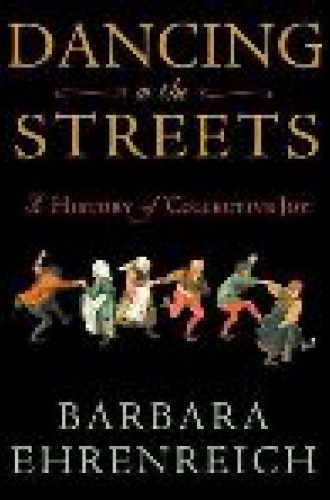Longing for ecstasy
Nostalgia is inherently selective. At some level we understand that the past we idealize has its flipside—that religious traditions in their heyday, for example, were perfunctory as well as inspiring, and that small-town life was oppressive as well as intimate. Watching Shakespeare in Queen Elizabeth’s London must have been thrilling, but only if the groundling next to you wasn’t coughing up untreatable germs. Nostalgia is a vision of retrospective hope, but the lenses we gaze through remain smeared with our needs.
Barbara Ehrenreich, author of the best-selling Nickel and Dimed, has provided a deeply nostalgic meditation on the place of ecstasy in human societies. Motivated by a “sense of loss,” Ehrenreich wonders why ecstatic rituals and festivities, once pervasive, are so rare today. Inside a culture fragmented by individualism and diluted by commercialism, the problem is not just the loss of community—plenty of others have explored that terrain. For Ehrenreich, the problem is a loss of the carnival rituals that once encouraged a “spiritual merger with the group” and promoted what Émile Durkheim called “collective effervescence.” Ehrenreich wants us to dance, and in the festive, spontaneous way that our ancestors did.
Can we lead-footed, inhibited types be forgiven for wondering whether the traditions she celebrates—Dionysian rituals, medieval fairs—are outdated or duly modernized already? Surely we have our equivalents, or else we have abandoned the rites for good reason. But Ehrenreich is not so sure, and like Nickel and Dimed, this book feels like a provocation—learned and measured, but still a cry of the heart more than a convincing argument.
The scope here is ambitious. Ehrenreich wants to convince us that group ecstasy is a universal human experience and thus a fundamental human need. To range from prehistoric cave drawings and Greek festivals, through the birth of Christianity, and on—via the Reformation and the Industrial Revolution—to the Beatles and Super Bowl halftime shows requires quick, anecdotal treatment.
Ehrenreich is something of a pilgrim historian, moving from glimpse to glimpse rather than lingering to prove her case. A single page shifts our attention from a female shaman in Somalia to Friedrich Nietzsche, and a discussion of the !Kung people of the Kalahari Desert follows hard on the heels of an analysis of Burton’s famed Anatomy of Melancholy. The canvas is broad, the brushstrokes are big. The resulting portrait serves not so much to illuminate the past as to mine it for examples of ecstatic rituals, and also of their suppression.
In Ehrenreich’s account, these rituals are part of what we need because we are human, but they also pose important challenges to social hierarchies. Dancing is a kind of democratic assertion: “It is tempting to divide the ancient temperament into a realm of Dionysus and a realm of Yahweh—hedonism and egalitarianism versus hierarchy and war.” This struggle persists in the modern world, and while in the West the forces of hierarchy triumphed, the impulse of spontaneous celebration never dissolved; it survived in peasant and Anabaptist movements during the Reformation, and in marches and demonstrations during the French Revolution; it takes perverse form in fascist rallies and occurs at rock concerts and in sports arenas in our own time.
These celebrations mimic older carnivals and testify to their power. And although their importance is partly emotional and psychological (“feeling part of something larger than ourselves”), the activity is also invariably political, as the authorities who suppress such gatherings know well. Carni- val-style activity is both indulgent and subversive, mocking authority (through figures such as the king of fools) and dissolving class and gender barriers (through costumes and masks). Ehrenreich notes that face paint and team colors, chants and dancelike rituals (think of the “wave”) generate a carnival atmosphere at sports events—although stripped of subversive intent. The same features appear at other venues: at Mardi Gras, of course, but also at political party conventions, where delegates wear all manner of strange hats and break into ritualized chants.
The contemporary world preserves these festive remnants, but for Ehrenreich they are either too infrequent or too remote from most people—who watch sports on TV, for example. Indeed, the very possibility of collective joy has been “largely marginalized to the storefront churches of the poor and the darkened clubs frequented by the young.” Even evangelicalism, with its “born-again moments of individual religious revelation,” is, “by and large, a cold and Calvinist business.”
Throughout the book Ehrenreich shows an awkward apprehension of religious experience and religious terms. She refers by turns to “ancient Israelis,” “Anglicism,” a “theologist” and “Christian evangelicists.” Given the prevalence of commentary about evangelicals in the press, the latter slip is particularly odd. Surely the participatory dynamic of many charismatic and Pentecostal churches is closer—and on a weekly basis—to what Ehrenreich idealizes than are the rock spectacles she describes. Yet Pentecostalism, in this whirlwind overview, warrants but a single sentence.
The larger issue, however, is whether Ehrenreich’s ecstatic ideal belongs to an earlier time. She knows that some readers will charge her with nostalgia (as I have done here), and she tries to head off the critique. Citing the “presumed incompatibility of civilization and collective traditions,” she frames a hypothetical challenge: “If you want antibiotics and heated buildings and air travel, you must abstain from taking hold of the hand of strangers and dancing in the streets.” But given the historical tendency of rulers to suspect and suppress almost every kind of gathering, and the comparative freedom in the modern West to peaceably assemble, doesn’t the absence of traditional ecstatic rituals also reflect a kind of spontaneous choice? And isn’t that a matter of our adjusting to our conditions, just as our ancestors adjusted to theirs? We could make a case—to pluck at random—for a return to the practice of people marrying at a much younger age. We could do this because we are nostalgic for extended families that get to know and nurture each other. Our urge for this would be understandable, but that wouldn’t make a decisive case for early marriage or show that marrying early is a fundamental part of being human.
Ehrenreich’s overall thrust has the presumption of truth. Who wants to criticize joy? Who would want to champion less ecstasy rather than more? But her vision is too pure and uniform. The ambiguity of ecstasy itself needs to be acknowledged. Is unmixed ecstasy necessarily good just because it’s instinctive? And is the quality of ecstatic connection to other people, or to something larger than ourselves, really higher than or preferable to other forms of communion? Is collective motion, in other words, a requirement of higher emotion?
The impulse of all nostalgia is toward completion. If only we had x (traditional families, manufacturing jobs, ecstatic rituals, prayer in schools, sandlot baseball), we would be whole. But our experience goes on spilling over its own edges, and our dilemmas usually involve the achievement of one good at the expense of another. In the world we inherited, advances of individual freedoms entail a necessary diminishment of unchosen community. Allegiances we choose will never be as organic or spontaneous as some of the communal rites Ehrenreich admires—and romanticizes. But it is hard to believe that these older experiences were unmixed joys. Who knows but that the enraptured figure we admire dancing on the Greek vase didn’t strike his servant when he got back home or resent his neighbors or maybe envy a Pythagoras his disciplined leisure, the thrill of shared ecstasy forgotten?






